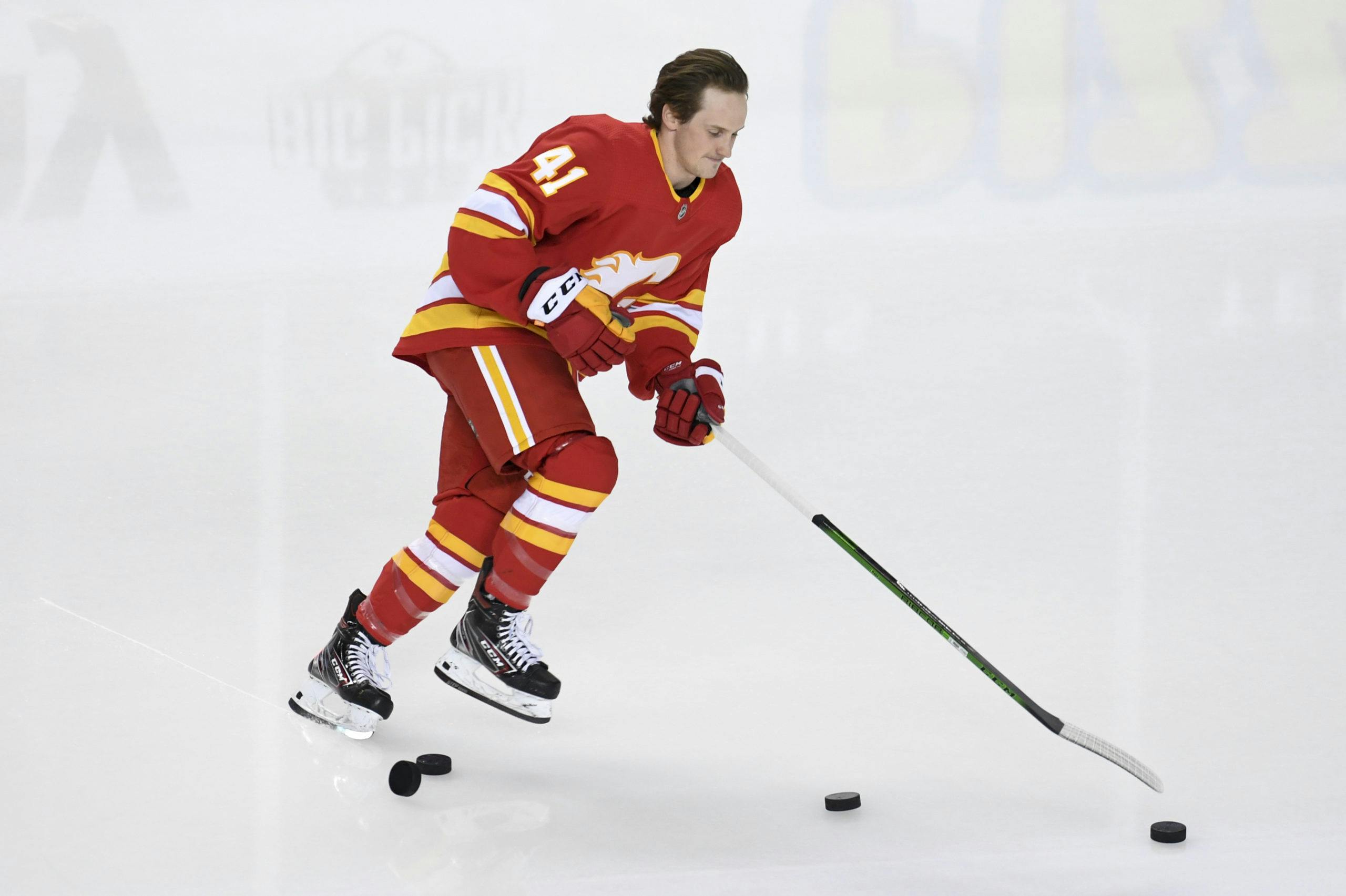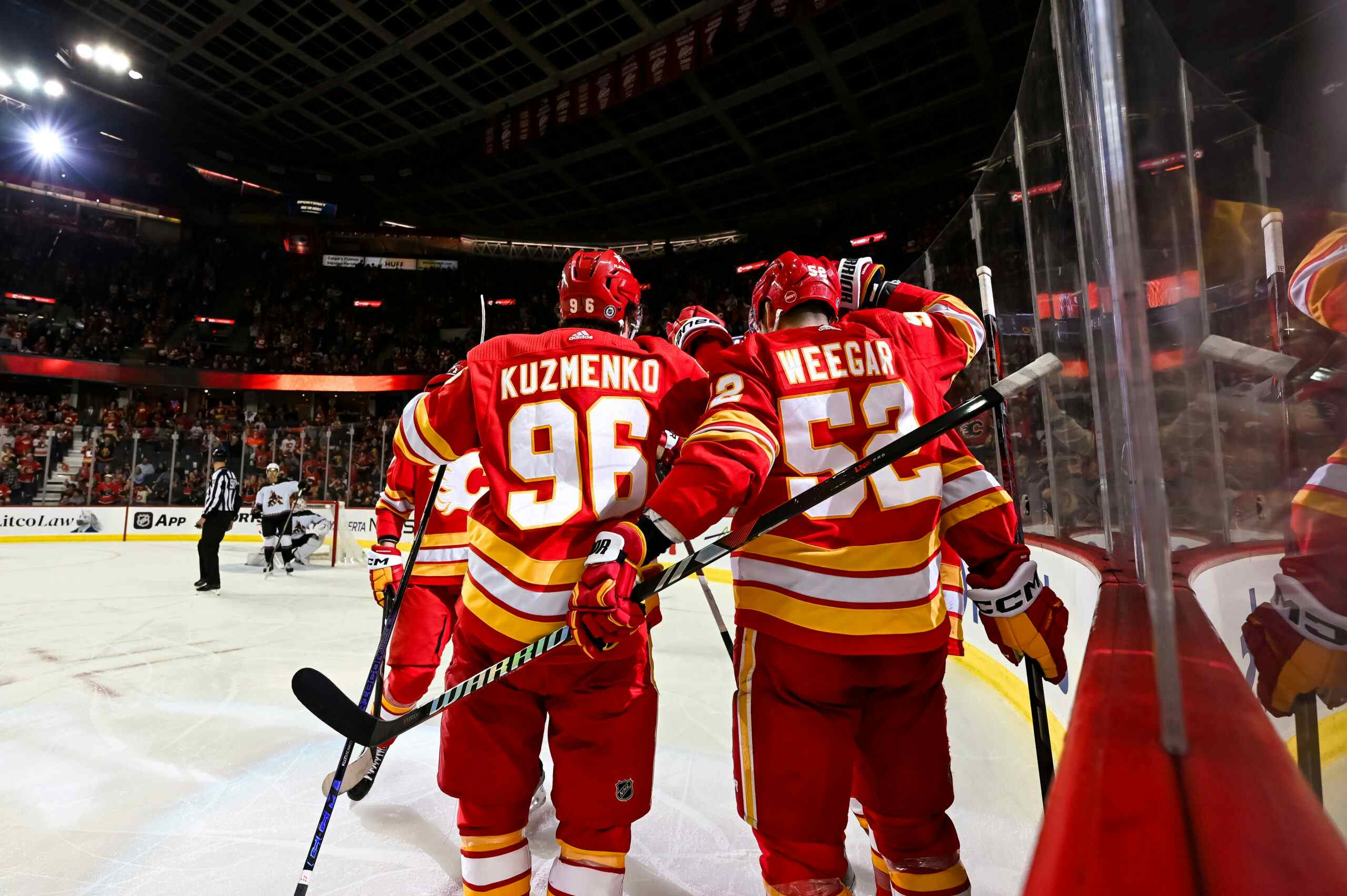Restating the case for the Flames to call up Matthew Phillips

By Mike Gould
2 years agoThe Calgary Flames need to find more ways to score goals.
@Johnny Gaudreau has been the team’s primary offensive driver all season long. @Matthew Tkachuk, @Elias Lindholm, and @Andrew Mangiapane have also been hugely important scorers for the 2021–22 Flames.
Collectively, those four players have scored 58 times for the Flames this season. The rest of Calgary’s forwards have combined to score just 31 goals. @Milan Lucic accounts for eight of those, and his current pace is almost assuredly unsustainable.
@Blake Coleman has been an excellent defensive forward this season but has yet to find his scoring touch as a Flame. @Dillon Dube has been doing a lot of good things in the offensive zone but he, too, is currently snakebitten.
Things look less certain for @Sean Monahan and @Mikael Backlund, both of whom have been key cogs down the middle for Calgary over the years but now appear to be in the midst of significant declines.
Nevertheless, Coleman, Backlund, Dube, and Monahan all have legitimate upside as complementary scoring threats. They’d potentially be able to thrive if surrounded by skilled offensive play drivers.
Here’s the problem, though: Calgary’s top unit, as presently constructed, is comprised of three of the team’s four primary offensive threats, leaving just one to aid the bottom three lines. Mangiapane is a good player but he’s not a miracle worker.
The Flames are short at least one top-six forward. We’ve known this for a while. But that’s not the only issue with their existing forward group.
Over the summer, the Flames made a series of low-risk, low-upside bets on veteran depth forwards, with the hope that they’d be able to chip in at both sides (or, at the very least, one side) of the ice.
After re-signing @Brett Ritchie and trading for @Tyler Pitlick, the Flames went out and gave one-year, $800,000 contracts to @Trevor Lewis and @Brad Richardson. All four of these players have spent time as regulars in the Flames’ lineup this season, with Ritchie most recently occupying a spot in the top six.
Ritchie also spent significant (read: way too much) time in a top-six role last season and the fact that he’s still being rotated through next to the likes of Mangiapane and Coleman is perplexing, to say the least.
Unfortunately, the Flames’ other depth options haven’t been any better this season.
382 NHL forwards have played more than 200 minutes at 5-on-5 this year. Only five of them have generated fewer individual expected goals per 60 minutes than @Tyler Pitlick. @Brad Richardson ranks 10th-worst in the NHL in the same category.
With Richardson on the ice at 5-on-5, the Flames have surrendered 41 high-danger chances while generating just 19. As a whole, the Flames have controlled 5-on-5 high-danger chances 291 to 255. The Flames are +36 in that category; Richardson, while being heavily sheltered, is -21. Not great.
Lewis is the only player out of those four to kill penalties, and he’s been rather useful in that role. It’s been a different story for him at 5-on-5, where his expected goals percentage ranks second-last on the team and he’s been out-chanced 174 to 138. Overall, the Flames are +163 in the scoring chances category this season.
Having one of Pitlick, Lewis, Ritchie, and Richardson in the lineup would probably be just fine. Two would be pushing it. Three? Not ideal.
Trevor Lewis has played all 32 games this season for Calgary. Tyler Pitlick has joined him for 24 of those contests. Brad Richardson has appeared in 22. Brett Ritchie is back in the lineup after missing two months to injury and is now up to 11 games and counting.
At the moment, it appears the Flames have room for three of those players in their lineup on any given night. Lewis, Ritchie, and Pitlick played against the Florida Panthers on Jan. 4; Richardson took Pitlick’s place two nights later against the Tampa Bay Lightning.
This should not continue. The negative offensive impacts these four players provide outweigh any perceived defensive or intangible value. Both Richardson and Lewis have also been suspect defensively at 5-on-5 this season. It’s time for the Flames to try something different.
The Stockton Heat — the Calgary Flames’ American Hockey League affiliate — look like a frontrunner for the Calder Cup this season. The Heat boast one of the league’s best goaltenders in @Dustin Wolf, an impressive defensive group headlined by @Connor Mackey, and a formidable forward lineup.
Stockton’s top line of @Jakob Pelletier, @Matthew Phillips, and @Glenn Gawdin has combined for 31 of the team’s 96 goals this season. All three of them rank among the AHL’s top 20 scoring leaders. Here’s a breakdown of their individual statistics:
- Jakob Pelletier: 27 GP, 11 G, 17 A, 28 P, 82 SOG, +16, 2 PPG
- Matthew Phillips: 24 GP, 10 G, 13 A, 23 P, 63 SOG, +17, 2 PPG
- Glenn Gawdin: 25 GP, 10 G, 16 A, 26 P, 51 SOG, +17, 3 PPG
Gawdin, 24, is the oldest of the trio and is also a pending unrestricted free agent. He’s averaging only slightly more than two shots per game and has also received the longest audition (nine games) in the NHL. With both his future in the organization and the height of his ceiling less certain, Gawdin has less of a case for a recall than either of his linemates.
We’ve gone over the pros and cons of the Flames recalling Pelletier, Stockton’s 20-year-old rookie phenom. He’s already one of the AHL’s top five scorers and appears destined to be a future NHL mainstay. How much more seasoning does he really need?
Even if the Flames elect to promote Pelletier, they should consider bringing up Phillips. The 23-year-old winger — now officially listed at 5’8″ and 165 pounds — has continued his upward trajectory this season and looks primed for his first legitimate NHL audition.
Phillips got into one glorified exhibition game at the very end of the 2020–21 regular season. The speedy right-shooting forward took two shots and posted a very respectable 79.67 expected goals percentage in 11:19 of 5-on-5 ice time, also appearing for 2:16 on the power play.
There isn’t a whole lot to take away from such a small sample, however (and the same applies to any pre-season games he’s played in a Flames sweater). What really matters is what Phillips has accomplished in his significant time at the AHL level.
In the shortened 2020–21 season, Phillips was the most dangerous offensive player on a depleted Heat roster and ended up tying for the team scoring lead with 21 points in 30 games. He’s been even more effective to start 2021–22.
Phillips, a natural playmaker, took 56 shots in 30 contests (1.87 per game) last season. In 2019–20, he managed 62 in 38 (1.63 per game). This season, Phillips is already up to 63 shots in just 24 games (2.63 per game) and has scored on 15.9% of them.
Over his 158-game AHL career, Phillips has scored on 46 of his 282 shots. That translates into a career 16.3 shooting percentage. Despite pacing for AHL career-high marks in every offensive category this season, Phillips is actually converting at slightly less than his normal rate. Not only is Phillips on fire, but he’s also likely to stay that way.
We’ve made the case for Phillips multiple times before. Here’s an excerpt from an article I wrote about him last May:
Even considering his improved volume, shots be damned if you’re Matthew Phillips. He’s a pure playmaker and can execute passes most AHLers could only imagine making.Phillips passes the puck with force, pin-point accuracy, and perfect elevation. He corrals the puck on his stick effortlessly and can move it laterally with dexterity almost unparalleled at the AHL level.He’s a creative offensive threat with superb instincts and easily enough raw talent to play NHL hockey.
Phillips remains one of the top playmakers in the AHL. He’s averaging a career-high 0.54 assists per game and routinely makes the highlight reels with assists like these:
(By the way, if plus/minus is your thing: Phillips’ +17 rating ranks second in the entire AHL this year).
Phillips is a clean player who seldom puts his team down a man. He’s a quick skater and an excellent puck handler. He’s also adept at quarterbacking a power play, often used as the main distributor on the left flank during 5-on-4 situations.
The Flames would easily be able to fit Phillips’ $750,000 cap hit into their NHL structure. He’s long been a productive offensive force in the AHL and he’s due to be rewarded. Ritchie, Pitlick, Richardson, and Lewis just aren’t cutting it.
Yes, the Flames should probably bring up Jakob Pelletier. In addition, they’d be smart to recall Matthew Phillips, who has continued to develop into a more exciting prospect with each passing season.
The Flames need more speed and skill. Phillips offers both of those qualities in spades. Even if you don’t think Phillips has the size or talent to be an NHLer, what do the Flames have to lose by giving him a shot over their existing depth options?
We’ll only know if Phillips isn’t good enough once we’ve seen him in action. If he is good enough — and there’s plenty of reason to hope he is — the Flames might be able to start addressing one of their problems.
THIS ARTICLE BROUGHT TO YOU BY DAILYFACEOFF

Looking to up your fantasy hockey game? DailyFaceoff has the tools you need for both daily and season-long fantasy leagues, including a lineup optimizer, daily projections, and a whole lot more. Sign up for the DailyFaceoff tools here.
Recent articles from Mike Gould





